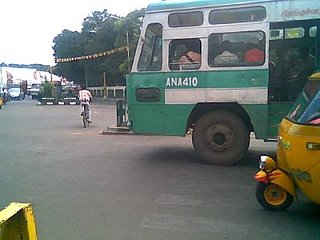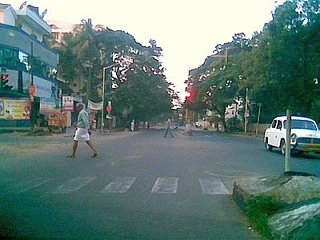Hello,I am back after a short visit to the UK, and as you can imagine, with a lot of new perspectives on why Chennai has among the worst roads anywhere.
Of course, the 'top' issue being discussed about Chennai's roads is the death of three people in a Hyundai Santro car during the intense rain that hit the city on Saturday (October 28) night.
It did not help any of the lakhs of motorists (or pedestrians) on that dark and rainy night that the police in chennai had 100 new cars donated by the same company whose Santro turned into a coffin for three people.
So why do people in Santro cars caught in heavy rain end up suffocating to death? Read the Times of India's report on the incident in Chennai here.
A search on the Internet reveals that the Chennai incident was not the first. It happened almost in identical fashion -- in a Santro -- in Mumbai in 2005.
Today's The Hindu has a report on how this sort of thing apparently happens. But the report does not deal with the impact of the jamming of the central locking on those who were trapped. What role did this play in causing the deaths?
This question is important because Hyundai has a duty to explain to its tens of thousands of customers, what it did after the Mumbai deaths, to determine the cause of the technical problem. Did Hyundai fix the problem in subsequent production of Santro? Why has it not ordered a recall of all Santros fitted with similar locks to assess whether they need to be changed or repaired?
Okay, even if this is too much to ask in a third world country with a significant number of corrupt politicians, bureaucrats and policemen, why has not Hyundai advertised an emergency number for its car owners, which will provide help if they are stranded?
And what is the Government in this Detroit of India doing for the vast number of people who have purchased cars?
Why is the Automobile Association of Southern India not coming up with some kind of response to such a tragedy?
Monday, October 30, 2006
Hyundai cars as coffins - in a rain, a Santro can kill you!
Monday, October 09, 2006
Angelina Jolie, Brad Pitt, Maddox and India's autorickshaw
The ubiquitous three-wheeled autorickshaw generally runs riot on India's urban and semi-urban landscape. This poorly-engineered ramshackle contraption which serves a small purpose as a feeder transport in most places has again shot to global fame as Angelina Jolie and Brad Pitt's runabout in Pune.
See the picture of Brad Pitt looking out of an autorickshaw here.
Many will remember the crazy scenes from the James Bond film Octopussy in which Vijay Amritraj drives an autorickshaw (specially engineered for the venture) like a bat out of hell ferrying Roger Moore.
A rather longish treatment of autorickshaws is available here on Wikipedia.
On Chennai Roads, though, the story of autorickshaws is not so much fun. Many passengers lose their limbs, some die and others suffer minor injuries each day, as the yellow three-wheelers race along city roads. All passengers are fleeced by market forces because there are not enough buses and trains for passengers.
The ubiquitous three-wheeled autorickshaw generally runs riot on India's urban and semi-urban landscape. This poorly-engineered ramshackle contraption which serves a small purpose as a feeder transport in most places has again shot to global fame as Angelina Jolie and Brad Pitt's runabout in Pune.
See the picture of Brad Pitt looking out of an autorickshaw here.
Many will remember the crazy scenes from the James Bond film Octopussy in which Vijay Amritraj drives an autorickshaw (specially engineered for the venture) like a bat out of hell ferrying Roger Moore.
A rather longish treatment of autorickshaws is available here on Wikipedia.
On Chennai Roads, though, the story of autorickshaws is not so much fun. Many passengers lose their limbs, some die and others suffer minor injuries each day, as the yellow three-wheelers race along city roads. All passengers are fleeced by market forces because there are not enough buses and trains for passengers.
Saturday, October 07, 2006
Wrong Idea
Surf blogs a bit to see what there is about Chennai, and you come across something like this. Someone has suggested the banning of autorickshaws in Chennai because they are a traffic nuisance.
This is exactly the sentiment that has driven Chennai's traffic insane. People imagine that if we sell more cars and two-wheelers (which you would have to completely depend on if autorickshaws were off the scene) the road scenario will get better! Nothing can be farther from the truth. The sensible thing to do would be to ensure that autorickshaws operate safely and abide by the law, and to increase the number of buses.
Fellow blogger Vasudevan Deepak Kumar is totally out of depth here.
Surf blogs a bit to see what there is about Chennai, and you come across something like this. Someone has suggested the banning of autorickshaws in Chennai because they are a traffic nuisance.
This is exactly the sentiment that has driven Chennai's traffic insane. People imagine that if we sell more cars and two-wheelers (which you would have to completely depend on if autorickshaws were off the scene) the road scenario will get better! Nothing can be farther from the truth. The sensible thing to do would be to ensure that autorickshaws operate safely and abide by the law, and to increase the number of buses.
Fellow blogger Vasudevan Deepak Kumar is totally out of depth here.
A law unto themselves
Let me begin this post by saying that I am completely in favour of buses. They hold the key to making our lives sustainable and they reduce our dependence on costly personal ways to get around town.
But what I find completely unacceptable is the manner in which the buses are driven in India. As someone who has lived in this country for four decades and more, I am familiar with the ways of our people. The bigger guy gets the right of way. The little guy who uses the road does not have a voice. He represents only the fare, if he chooses to use the bus. The question of buses existing for mobility of people is forgotten.
 That is the kind of arrogance that one comes across in Chennai. Look at the Metropolitan Transport Corporation bus blocking off the pedestrian corssing in this scene at Periyar Bridge intersection on Anna Salai. There are at least three policemen here on duty all the time. Not one would care to even question such bus drivers. Finally, when government-run buses don't care for the law, will others feel compelled to? You can also see the faded zebra crossing lines in this picture.
That is the kind of arrogance that one comes across in Chennai. Look at the Metropolitan Transport Corporation bus blocking off the pedestrian corssing in this scene at Periyar Bridge intersection on Anna Salai. There are at least three policemen here on duty all the time. Not one would care to even question such bus drivers. Finally, when government-run buses don't care for the law, will others feel compelled to? You can also see the faded zebra crossing lines in this picture.
Let me begin this post by saying that I am completely in favour of buses. They hold the key to making our lives sustainable and they reduce our dependence on costly personal ways to get around town.
But what I find completely unacceptable is the manner in which the buses are driven in India. As someone who has lived in this country for four decades and more, I am familiar with the ways of our people. The bigger guy gets the right of way. The little guy who uses the road does not have a voice. He represents only the fare, if he chooses to use the bus. The question of buses existing for mobility of people is forgotten.
 That is the kind of arrogance that one comes across in Chennai. Look at the Metropolitan Transport Corporation bus blocking off the pedestrian corssing in this scene at Periyar Bridge intersection on Anna Salai. There are at least three policemen here on duty all the time. Not one would care to even question such bus drivers. Finally, when government-run buses don't care for the law, will others feel compelled to? You can also see the faded zebra crossing lines in this picture.
That is the kind of arrogance that one comes across in Chennai. Look at the Metropolitan Transport Corporation bus blocking off the pedestrian corssing in this scene at Periyar Bridge intersection on Anna Salai. There are at least three policemen here on duty all the time. Not one would care to even question such bus drivers. Finally, when government-run buses don't care for the law, will others feel compelled to? You can also see the faded zebra crossing lines in this picture.
Chennai : An early morning scene
The first hour in the morning (around 6 am) is generally fraught with danger on the city roads. Today, I found that a lorry carrying bottled water had crashed into a street lamp near the Udhayam Theatre in Ashok Nagar. The area was strewn with glass and plastic, and the mangled lamp post blocked part of the road. I wonder whether the driver was drunk or sleepy?
Further towards Kodambakkam, I took a picture of the road intersection just outside the Ashok Nagar police station. As you can see, there is no police presence and great caution is necessary in crossing the road. The fading "zebra crossing" markings are of little help, and the traffic signal, even less. It is extremely dangerous to imagine that motorists will obey rules at such intersections. Whether they are government buses, tourist taxis or private cars, most don't care about the traffic lights. So watch out!
As you can see, there is no police presence and great caution is necessary in crossing the road. The fading "zebra crossing" markings are of little help, and the traffic signal, even less. It is extremely dangerous to imagine that motorists will obey rules at such intersections. Whether they are government buses, tourist taxis or private cars, most don't care about the traffic lights. So watch out!
The first hour in the morning (around 6 am) is generally fraught with danger on the city roads. Today, I found that a lorry carrying bottled water had crashed into a street lamp near the Udhayam Theatre in Ashok Nagar. The area was strewn with glass and plastic, and the mangled lamp post blocked part of the road. I wonder whether the driver was drunk or sleepy?
Further towards Kodambakkam, I took a picture of the road intersection just outside the Ashok Nagar police station.
 As you can see, there is no police presence and great caution is necessary in crossing the road. The fading "zebra crossing" markings are of little help, and the traffic signal, even less. It is extremely dangerous to imagine that motorists will obey rules at such intersections. Whether they are government buses, tourist taxis or private cars, most don't care about the traffic lights. So watch out!
As you can see, there is no police presence and great caution is necessary in crossing the road. The fading "zebra crossing" markings are of little help, and the traffic signal, even less. It is extremely dangerous to imagine that motorists will obey rules at such intersections. Whether they are government buses, tourist taxis or private cars, most don't care about the traffic lights. So watch out!
Fatal tracks
Safety is not one of the strongpoints of people in the Indian subcontinent. How else can one explain the unconcern about a large number of people dying in avoidable circumstances on railway tracks?
The general public view is that the railway stations in India have facilities that are hostile to pedestrians, and hence it is acceptable to take risks -- such as crossing over on tracks, rather than use an overbridge.
One cannot quarrel with the view of the commuters on the nature of facilities, but the risks can sometimes be too extreme. Today's The Hindu carries the report of three people getting killed in the suburbs, trying to cross the railway track.
Safety is not one of the strongpoints of people in the Indian subcontinent. How else can one explain the unconcern about a large number of people dying in avoidable circumstances on railway tracks?
The general public view is that the railway stations in India have facilities that are hostile to pedestrians, and hence it is acceptable to take risks -- such as crossing over on tracks, rather than use an overbridge.
One cannot quarrel with the view of the commuters on the nature of facilities, but the risks can sometimes be too extreme. Today's The Hindu carries the report of three people getting killed in the suburbs, trying to cross the railway track.
Subscribe to:
Posts (Atom)
